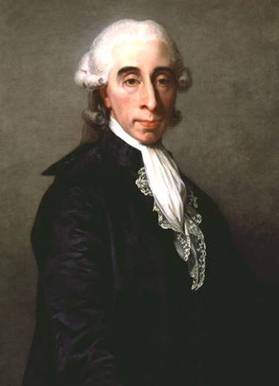This Week in History
July 13-19, 2014
225th Anniversary of July 14, 1789:
Why Bastille Day Must Be a Reminder
Never To Repeat History
by Pierre Beaudry
I have often asked myself the question: “What would Americans be thinking if they were to make the date of 9/11 the celebration of their Liberation Day?” The answer is that they would have to be thinking, like the British and French oligarchies that established the terrorist fraud of Bastille Day as the day of liberation for the French people on July 14, 1789. However strange this question may appear to be, it is not a moot question, and the answer requires that we look a little more deeply into the difference of principle between the American Revolution and the French Revolution.
 Jean Sylvain Bailly (1736-1793). |
Although the French Revolution started as an impulse to repeat the American Revolution, the two historical realities, separated by a mere thirteen years in time, went into two completely different directions as to matters of principle. The American Revolution was fought for the general welfare of all of the peoples of the world, as was established at the Peace of Westphalia of 1648, for the benefit of the other, and as was resolved by understanding Nicholas of Cusa’s paradox of the unity of opposites. The French Revolution was sabotaged and turned into a counter revolution that killed its own people through a terror orchestrated by the British Empire and the French oligarchy. [See, for example, how the first President of the National Assembly, Jean-Sylvain Bailly, initiated a true revolution at the Tennis Court Oath on June 20, 1789, and yet, he was guillotined four years later by the Revolutionary Tribunal on June 20, 1793. Jean-Sylvain Bailly: The French Revolution's Benjamin Franklin.]
Politically and conceptually, the French Revolution was an explicit break with the Peace of Westphalia, and was based on the British principle of taking advantage of the other and excluding him. The French Revolution created Right and Left political parties that were incompatible entities inside of their National Assembly, where the nobility sat on the right side of the assembly hall, and the republican citizenry sat on the left side of the same room; each excluding the other. The same party interest divides the French Assembly today. The purpose of such a divided assembly was to maintain the interest of the party above the interest of the nation as a whole. This is how the rule of parliamentary party politics was instituted in France in 1789 by the British in order to keep the people divided. As a result, the French Revolution ended in a disaster that could only be described by our beloved poet Friedrich Schiller as “a great moment that met a little people.”
On the other hand, with the American Revolution, George Washington and Alexander Hamilton established a single all inclusive party of republican patriots for the benefit of all and for the general welfare of all. Only a single party of patriots can effectively establish the benefit of all others, because the point of a true liberation is to give the self-governing body of the people the ability to solve national and international problems, as Cusa was able to bring together the unity of the opposites in such harmony that the sovereignty of a single nation, or individual, could become the necessary impetus for the development of all other nations of the world for the benefit of all of mankind. Such was the idea of America that Cusa had in mind.
Nevertheless, not all was a lost in the terror of the French Revolution. Aside from the heroic contributions of Jean-Sylvain Bailly, it was the “Organizer of the Victory,” educator and member of the Legislative Assembly, Lazare Carnot, who best captured the American spirit of the Revolution, when he declared that his principle of “enthusiasm” was meant for the purpose of “elevating to the dignity of human beings all the individuals of the human species.” But, the point to be understood is that the British Empire had a completely different plan in mind.
As the story of Cagliostro and the Necklace Affair demonstrates, the Bastille terrorist Coup of 1789 had been planned nine years before it took place in a London-run terrorist operation known as the “Gordon Riots.” On June 7th, 1780, a notorious British intelligence asset named Lord George Gordon, later to be associated with the Italian freemasonic occultist adventurer, Cagliostro (aka Giuseppe Balsamo), in an operation of defamation against Marie Antoinette, stormed the strongest prison in England, the Newgate London Prison, which was burned to the ground and demolished completely within a few hours in a fit of popular rage.
That same operation was run in France nine years later on July 14, 1789 at the Bastille Prison of Paris, the strongest prison of France, which was burned down and completely destroyed on the same day. Both terrorist operations were run by British intelligence, and both served as modern asymmetric warfare models of “purgative violence” for the purpose of terrorizing the general population into submission, to render it impotent in the face of a terror operation run by its own government. The Bastille Coup was overseen by the Duke of Orléans, Philippe Egalité, the Finance Minister, Jacques Necker, and the freemasonic leader of the Martinist of Lyon, the French controller of Cagliostro, Joseph de Maistre. Both terrorist operations had been conducted under the authority of Lord Shelburne and Jeremy Bentham. If you wish to know the whole story, read the following related pages and act to defeat oligarchy and its puppets forever.
